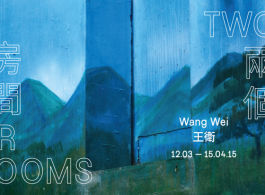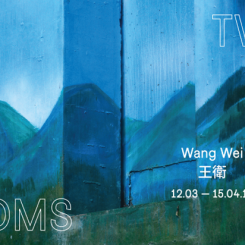Two Rooms (2015) is an immersive installation created by the Beijing – based artist Wang Wei (b. 1972). Conceived not so much as an artwork but rather a vehicle for situating artifice in the context of everyday life, the installation builds upon Wang Wei’s interest in the Beijing Zoo; upon a visit in 2007 he was struck by the wall designs of the animal enclosures – were they intended for the humans or the animals? These evident fictions or ‘natural’ habitats have since inspired several installations exhibited at the Kunsthalle Project Space, Vienna as well as Observation Society, Guangzhou amongst other locations. Each project, including Two Rooms at Edouard Malingue Gallery, is an appropriation of an existing space and its visual elements, which Wang Wei then enlarges and adapts to a gallery setting. Through a process of identification, engagement and decontextualisation, Wang Wei questions the veracity of natural forms before fresh eyes and constructs windows for the investigation of new layers of meaning.
A graduate from the Fresco Painting Department of the Central Academy of Fine Arts in 1996, Wang Wei was already concerned with the principle tenets of space, viewer interaction and sensory perception. As a member of the artistic and curatorial ‘Post – Sense Sensibility’ movement in the late 1900s early 2000s, Wang Wei later developed an ad hoc spirit 1, a key ingredient that would bring Wang Wei’s work not only into the realm of installation but that of performance carved out of a space. To varying degrees, each of Wang Wei’s works inspired by the Beijing Zoo have channeled this dichotomy between structure and interaction. A Zoo, No Animals (2007), the first Beijing Zoo work exhibited in the city itself, brought abandoned animal cages into an art space, which visitors would then pass through thus inhabiting the cage – like structures, whilst being stripped of immediate context.
Two Rooms follows from this last project, involving two floor- to-ceiling panels that cover the length and height of the gallery walls. As suggested by the title, two scenarios are cast, each depicting a separate room at the Beijing Zoo’s Baboon House. Tonally distinct, one represents dusk/Autumn, whilst the other casts Spring/dawn. Created specifically for Edouard Malingue Gallery, the installation plays with the gallery layout, and leads the viewer through the undulations of the space till they are ultimately faced with the large ‘Spring/dawn’ room, which presents a florid and mountainous landscape under a tepid red sky. Having at first been faced with the ‘dusk/Autumn’ room, the viewer notes that the painted forms are remarkably similar – the mountains, odd trees, forms of foliage –signaling ultimately the repetitive monotony of the artificial setting; immersive, yet nonetheless vacuous.
Ultimately, Two Rooms (2015) conveys Wang Wei’s persistence upon space and immersion. On the one hand, by inserting and recasting the backgrounds of these cages within the ‘white cube’, he decontextualises the original and highlights its fiction and absurdity. On the other hand, by altering the space of the ‘white cube’, he challenges the spaces’ character and breaks down the gallery’s supposed neutrality. This in itself is a great challenge, for Wang Wei is not altering the space’s meaning through hanging its architecture, but rather by immersing it in a constructed narrative sequence, replete with visual impressions that ultimately have intellectual and bodily repercussions.
Wang Wei’s work has been exhibited in numerous important exhibitions including: 12th Chinese Pavilion, International Architecture Exhibition, La Biennale di Venezia, Italy (2010); Shenzhen Hong Kong Bi – City Biennale of Architecture and Urbanism, Shenzhen, China (2009); The Real Thing: Contemporary Art From China, Tate Liverpool, UK (2007); Foreign Objects, Kunsthalle Wien Project Space, Vienna, Austria (2007); Beyond: The Second Guangzhou Triennial, Guangdong Museum of Art, (2005); A Second Sight, International Biennale of Contemporary Art, National Gallery in Prague, Czech Republic, (2005); Between Past and Future: New Photography and Video from China, International Center of Photography, New York (2004); The First Guangzhou Triennial, Guangdong Museum of Art, China, (2002).






